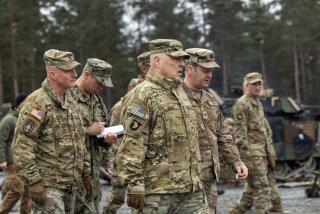War Exercises Charged With Dose of Reality
- Share via
FT. POLK, La. — The mortar shells began falling at 1 a.m. Wednesday, shattering the silence of a moonless night as the 1st Brigade of the famed 101st Airborne Division began the assault on a mock city deep in a pine forest.
Soldiers had descended by rope from helicopters hovering two miles from town, and using smoke bombs and heavy automatic fire they had breached the city within 45 minutes of launching the first attack.
“Gators are in!” shouted Spc. Jason Symmes, signaling that his squad had gained control of its first building.
The intense cross-fire between the 101st Airborne unit and a “rebel” squad of Army soldiers that had taken refuge in the city was only an exercise. The troops fired blank ammunition. They also used rifles equipped with laser pointers and wore small devices on their bodies that beeped when the laser of another gun was pointed at them. Upon hearing the beep, an observer decided whether a soldier was considered killed or injured.
But the exercise provided a rare glimpse at how ground operations might take place in Afghanistan as the U.S. military prepares to shift from what has mostly been an air campaign to warfare involving foot soldiers.
For the 101st Airborne, which often is one of the first to send units into a military engagement, the exercise was particularly meaningful, because it could represent the troops’ last training before seeing real action.
Army officials insisted that the 11-day exercise--culminating with Wednesday’s final battle--was not preparatory for any specific conflict, including Afghanistan. But it did provide soldiers with invaluable experience and lessons that could help improve their fighting skills in actual combat, they said.
“What we do out here translates very well with any environment they’ll get into,” said Brig. Gen. Charles H. Swannack Jr., commander of the Joint Readiness Training Center here. “The realistic battlefield is useful to any force that comes in here.”
Indeed, the all-night battle involving ear-piercing simulated mortar shell blasts, helicopter gunship fire and artillery bombardments was not far from a real one they might encounter in Afghanistan, the soldiers said.
The airborne unit used Humvee-mounted .50-caliber machine guns and Apache helicopters. The “enemy” was armed with machine guns, Stinger-like surface-to-air missiles and a Russian helicopter gunship supplied by a private company.
“We need to do a lot more of these because [this is] the kind of fighting we will do,” said Pfc. Brandon McDougald, a 20-year-old native of Sequim, Wash., whose squad “lost” five men in the battle for Shughart-Gordon. The mock town is named after two Medal of Honor recipients who died in Somalia in 1993 trying to save a helicopter pilot.
McDougald said he was looking forward to fighting in Afghanistan. “I would like to go to see whether all this training pays off,” he said.
But his partner, Lauriano Farias of San Diego, wasn’t so sure. He is married with a 3-year-old son and another child on the way. “It’s good that we go, but I’m worried about my family,” Farias, 22, said.
With the thought of being deployed to Afghanistan weighing heavily on many soldiers during the exercise, the battle for the town seemed far more intense than usual, longtime observers said. Since the Sept. 11 terrorist attacks and the start of the military campaign in Afghanistan on Oct. 7, there has been a definite change in the way the soldiers carry out the exercises, said John Dennyson, a retired federal worker who regularly plays a civilian caught in the middle of a battle during such exercises.
“It’s gotten more serious,” Dennyson said. “They’re very aggressive because they know they may have to do the same thing soon.”
The skirmish for an apartment complex on the western edge of town was particularly intense, with the two sides engaging in a heated firefight within shouting distance of each other.
Each time the enemy--really the 3rd Battalion, 327th Infantry Regiment--fired from its second-story window, it was met with an equally intense response.
Providing battle realism in this particular case even involved having some horses, chickens and geese in the town.
“Geese make a hell of a noise when you get near the barbed wires,” said Maj. Mark Davis, a planner at the training center.
Shughart-Gordon has 29 buildings constructed at a cost of $12 million. There is a hotel, church, hospital and gas station.
More to Read
Sign up for Essential California
The most important California stories and recommendations in your inbox every morning.
You may occasionally receive promotional content from the Los Angeles Times.










